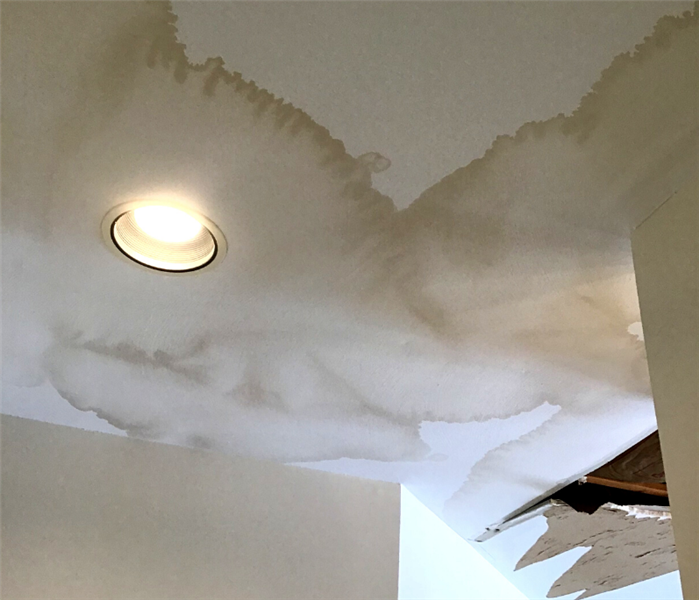Ceiling Water Damage Repair Tips For Connecticut Homeowners
3/15/2021 (Permalink)
 When your ceiling leaks, it can cause serious structural problems and mold in your home, requiring ceiling water damage repair.
When your ceiling leaks, it can cause serious structural problems and mold in your home, requiring ceiling water damage repair.
When you notice water stains or a ceiling leak in your Connecticut home, you may not be sure what your first step should be. Who should you call? Can you repair ceiling water damage yourself? Here we will review what to do when you find ceiling damage from a water leak in Connecticut.
What To Do When Your Find Ceiling Water Damage
Take the following steps when you have a ceiling leak or find signs of water damage on ceilings inside of your Connecticut home.
1. Find the Source of Your Ceiling Leak
Before you can effectively repair ceiling water damage, you must address the source of what's causing it. Depending on where the ceiling damage is in your home, there are numerous possible sources of moisture.
Tips to find the source of your ceiling leak:
- Investigate the room above the affected ceiling. You may be dealing with a leaking pipe, toilet, or shower
- If there's no rooms above the affected ceiling, investigate your attic and roof for leaks from loose shingles or ice dams
- If you cannot find the source, it's likely between the ceiling and above floor
Once you find the source of the leaking ceiling in your home, you can have the needed repairs made and move on to your water damage ceiling repair.
2. Inspect Your Damages
Depending on how long the leak in your ceiling was going on for, you may only need to dry out the ceiling and fix some peeling paint, or completely replace the ceiling and maybe even the flooring below it.
You should inspect the areas above and below where your ceiling leak was located to spot any signs of mold growth or structural damage, such as rotting wood, deteriorating ceiling joists, or buckling or bending of ceilings or walls.
If you notice any signs of mold growth or structural problems, you should call a local water damage restoration company in Connecticut. These companies can fully restore your home, remediate mold, and even address structural issues before they become too serious.
3. Make Needed Ceiling Repairs
When performing ceiling water damage repair in Connecticut by yourself, you should be sure to take the following steps.
- Make sure that any wet or damaged drywall is completely dried or replaced as needed.
- If taking down damaged drywall or ceilings, be sure to put down tarps or drop cloths to catch dust, pieces of drywall, and other debris.
- Be sure to wear safety glasses.
- Do not paint over ceiling water stains unless you are sure it is completely dry. If you don't, you may end up with a mold problem.
- When repainting over the damaged area, paint the whole wall or ceiling so that there is no discoloration.
When Should You Call A Professional For Ceiling Water Damage Repair in Connecticut?
While ceiling leaks can be minor enough for Connecticut homeowners to repair themselves, there are times where you should always call a professional ceiling water damage repair company.
- When You're Dealing With Contaminated Water
Did you know that there are different types of water damage? When you're dealing with anything other than Category 1: Clean Water, you should call a professional.
- Category 1: Clean Water - This is water from a clean source, such as a broken clean water supply line or faucet.
- Category 2: Gray Water - This water has a significant level of contamination that could cause discomfort or illness if ingested. Sources include washing machine overflow; toilet overflow with some urine, but no feces; or dishwasher overflow.
- Category 3: Black Water - This water is grossly unsanitary and could cause severe illness or death if ingested, and any contact should be avoided. Sources for category 3 water could include flooding from rivers or streams, water from beyond the toilet trap, water from the toilet bowl with feces, or standing water that has begun to support microbial growth.
- When There's Structural Problems
If your ceiling leak has caused the ceiling or walls to sag, buckle, or completely collapse - you should call a professional to deal with the damages. Without taking the proper steps, you only make it more likely for problems to worsen inside of your Connecticut home and become more expensive to address over time.
- When There's Mold
If mold has already begun to grow in the water damaged area, you should call a professional. This is because if mold is present, your leak has likely been ongoing and caused more extensive damage than there may seem. Additionally, if mold isn't properly taken care of, it can continue to grow and spread around your home and cause an infestation.
Signs of Ceiling Water Damage
There are many signs of water damage on ceilings that can allow you to catch the problem before it causes structural damage to your Connecticut home. Signs include:
- Water stains on ceiling or discoloration
- Sagging ceiling
- Bubbling paint, possibly full of water
- Mold growth on ceiling
- Active leak through ceiling
We Provide Ceiling Water Damage Repair Services in Connecticut
When you're dealing with ceiling water damage in Connecticut, SERVPRO of Branford/Shoreline's water damage restoration specialists can make it "Like it never even happened."
- 24/7 Emergency Response
- IICRC Certified Water Damage and Mold Remediation Specialists
- In-House Construction Division
- We Handle The Insurance Process For You!
- Free Damage Restoration Estimates






 24/7 Emergency Service
24/7 Emergency Service